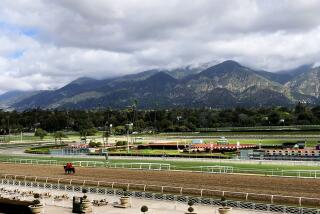Outrigger Racers Enjoy Paddling Their Own Canoes, Hawaiian Style
- Share via
The first time Kris Dahlin visited Catalina Island was 16 years ago, when he paddled there from Long Beach in a six-man outrigger canoe.
About a dozen canoes competed in a 31-mile race that took Dahlin’s team more than five hours to complete. The race was both grueling and exhilarating--the kind of experience that hooked him on canoe racing.
“You’re out there working hard and you see nothing; then all of a sudden you can see the outline of the island,” said the 38-year-old owner of a computer-installation company. “We rode the canoe all the way onto the beach. It’s things like that that make you really happy.”
Although it has not yet made as big a splash as another sport that originated in Polynesia--surfing--outrigger canoe racing in California has grown in popularity over the past few years with 17 clubs, averaging 50 members each, dotting the coast from Santa Barbara to the Mexican border.
Three clubs--Marina del Rey Outrigger Canoe Club, Kai Nalu Outrigger Canoe Club and Venice Outrigger Canoe Club--are based in Marina del Rey at Mother’s Beach.
“I’ve seen it really grow,” said Chris Paikuli, a paddler with the Marina del Rey club. “We’ve grown from 30 people (in 1984) to more than a hundred. The women, especially, have gotten better and better.”
Women Compete
Paikuli, 36, is the oldest member of the women’s team for Marina del Rey. She was preparing to compete today as a member of a team from Newport Beach in the sport’s premier event: the 46-mile Molokai-to-Oahu race.
The Downey native said she picked up the sport when she married a Hawaiian several years ago and moved to the Big Island of Hawaii.
“It’s a cultural thing there,” said Paikuli, who has two daughters, Pua and Nani, who also paddle. “All of our friends did it. Everybody did it.”
When she moved back to California she continued paddling, this season practicing twice a week for two hours after work.
“I find it a great stress relief, especially here in Los Angeles,” said Paikuli, who sells photocopiers for a living. “I’ve come down here in horrible moods, until we do a couple of sprints. Then I’m not crabby anymore.”
Leah Baumgartner, 24, a student at Santa Monica College, said she first tried paddling at the urging of a young man she met while weightlifting.
“I liked it,” said Baumgartner, who throws the javelin for the college track team. “I was always on the beach, anyway. I always hung out with a bunch of surfers and swimmers, so it just seemed natural.”
Now Baumgartner is one of the most dedicated members of the team. She came to practice even on a day when the temperature reached 104 degrees, Paikuli said.
“They sent me home,” Baumgartner said. “I didn’t paddle.”
“Some of my friends go, ‘Why do you do it? You don’t make any money,’ ” she said. “I just say if I didn’t do it, I wouldn’t know what to do with myself.”
Clubs Competitive
Marina del Rey coach Steve Kekuewa said athletes such as Baumgartner are making the California clubs increasingly competitive against Hawaiian and Tahitian clubs.
It is a sport that requires strength, timing and technique. “Once you get that, it’s all conditioning,” said Kekuewa, a Hawaiian who learned to paddle canoes off Waikiki Beach.
“You (also) have to be competitive,” he said. “You can’t just sit in the canoe and watch other people go by you. You have to want to beat them.”
The clubs paddle their 40- to 45-foot, 400-pound canoes in races that range from sprints of a few miles to long-distance races in the open ocean that stretch up to 40 miles. The racing season in California starts in May and ends in August, with the race to Catalina.
“This is probably one sport, more than football and baseball, that is a team sport,” said Greg Shaghoian, coach of Kai Nalu. “All six guys have to be doing the same thing. There are no superstars per se. One guy can be 10 times better than everyone else, but if everyone is not working together, the canoe is not going to move.”
While competition may be one reason canoe racing has grown in popularity, paddlers also mention its social, cultural and even spiritual aspects: the camaraderie among teammates, the post-race luaus, the Hawaiian blessings.
“It’s a family kind of thing,” said Shaghoian, who has been a paddler since 1969 and fondly remembers Noah (Grandpa) Kalama, a Hawaiian he called the father of California canoe racing. “Before the races, he would bless the paddlers and the canoes in Hawaiian. After the race everyone would get together and eat the Hawaiian food and start playing the Hawaiian music.
“We don’t have many Hawaiians right now,” Shaghoian said. “In the past 10 years, the sport has been taken over by the haoles (Caucasians), as they say.”
More to Read
Sign up for The Wild
We’ll help you find the best places to hike, bike and run, as well as the perfect silent spots for meditation and yoga.
You may occasionally receive promotional content from the Los Angeles Times.






